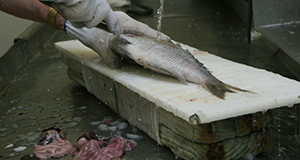Abstract
Cellular agriculture offers a groundbreaking approach to seafood production, where fish cells are cultivated to produce fish meat without traditional fishing or aquaculture. This method promises to meet the growing demand for seafood and addresses critical issues such as overfishing and habitat destruction. Fish waste, including fish skin, is a significant byproduct of the seafood industry that is often discarded; however, using fish waste as a resource for cell-based seafood production emerges as a compelling solution. Integrating fish waste into the production process can enhance the sustainability and efficiency of cellular agriculture. This approach aligns with the principles of the circular bioeconomy, transforming waste into valuable inputs and closing the loop in seafood production. This EDIS publication provides information on the potential of fish skin and other fish waste materials to be used as natural sources in cell-cultivated seafood production and its scaffolding.
References
Ahmad, K., J. -H. Lim, E. -J. Lee, H. -J. Chun, S. Ali, S. S. Ahmad, S. Shaikh, and I. Choi. 2021. “Extracellular Matrix and the Production of Cultured Meat.” Foods 10 (12): 3116. https://doi.org/10.3390/foods10123116
Arvanitoyannis, I. S., and A. Kassaveti. 2008. “Fish Industry Waste: Treatments, Environmental Impacts, Current and Potential Uses.” International Journal of Food Science & Technology 43 (4): 726–745. https://doi.org/10.1111/j.1365-2621.2006.01513.x
Esmaeili, A., E. Biazar, M. Ebrahimi, S. Heidari Keshel, B. Kheilnezhad, and F. Saeedi Landi. 2023. “Acellular Fish Skin for Wound Healing.” International Wound Journal 20 (7): 2924–2941. https://doi.org/10.1111/iwj.14158
Food and Agriculture Organization of the United Nations (FAO). 2024. The State of World Fisheries and Aquaculture 2024 – Blue Transformation in Action. https://doi.org/10.4060/cd0683en
Good Food Institute. n.d. “Scaffolds for Seafood.” Dive Deep: Cultivated Meat Scaffolding. Accessed April 10, 2023. https://gfi.org/science/the-science-of-cultivated-meat/deep-dive-cultivated-meat-scaffolding/#scaffolds-for-seafood
Kamalvand, M., E. Biazar, M. Daliri-Joupari, F. Montazer, M. Rezaei-Tavirani, and S. Heidari-Keshel. 2021. “Design of a Decellularized Fish Skin as a Biological Scaffold for Skin Tissue Regeneration.” Tissue and Cell 71: 101509. https://doi.org/10.1016/j.tice.2021.101509
Lee, S.-H., and J. Choi. 2024. “Three-Dimensional Scaffolds, Materials, and Fabrication for Cultured Meat Applications: A Scoping Review and Future Direction.” Food Hydrocolloids 152: 109881. https://doi.org/10.1016/j.foodhyd.2024.109881
Nelluri, P., R. Kumar Rout, D. Kumar Tammineni, T. J. Joshi, and S. Sivaranjani. 2024. “Technologies for Management of Fish Waste & Value Addition.” Food and Humanity 2: 100228. https://doi.org/10.1016/j.foohum.2024.100228
Poinski, M. 2021. “Why Finless Foods is taking the plunge into plant-based fish.” Food Dive, August 9. https://www.fooddive.com/news/why-finless-foods-is-taking-the-plunge-into-plant-based-fish/604051/
Waltz, E. 2021. “No Bones, No Scales, No Eyeballs: Appetite grows for cell-based seafood.” Nature Biotechnology, November 15. https://www.nature.com/articles/d41587-021-00022-6

This work is licensed under a Creative Commons Attribution-NonCommercial-NoDerivatives 4.0 International License.
Copyright (c) 2024 UF/IFAS

